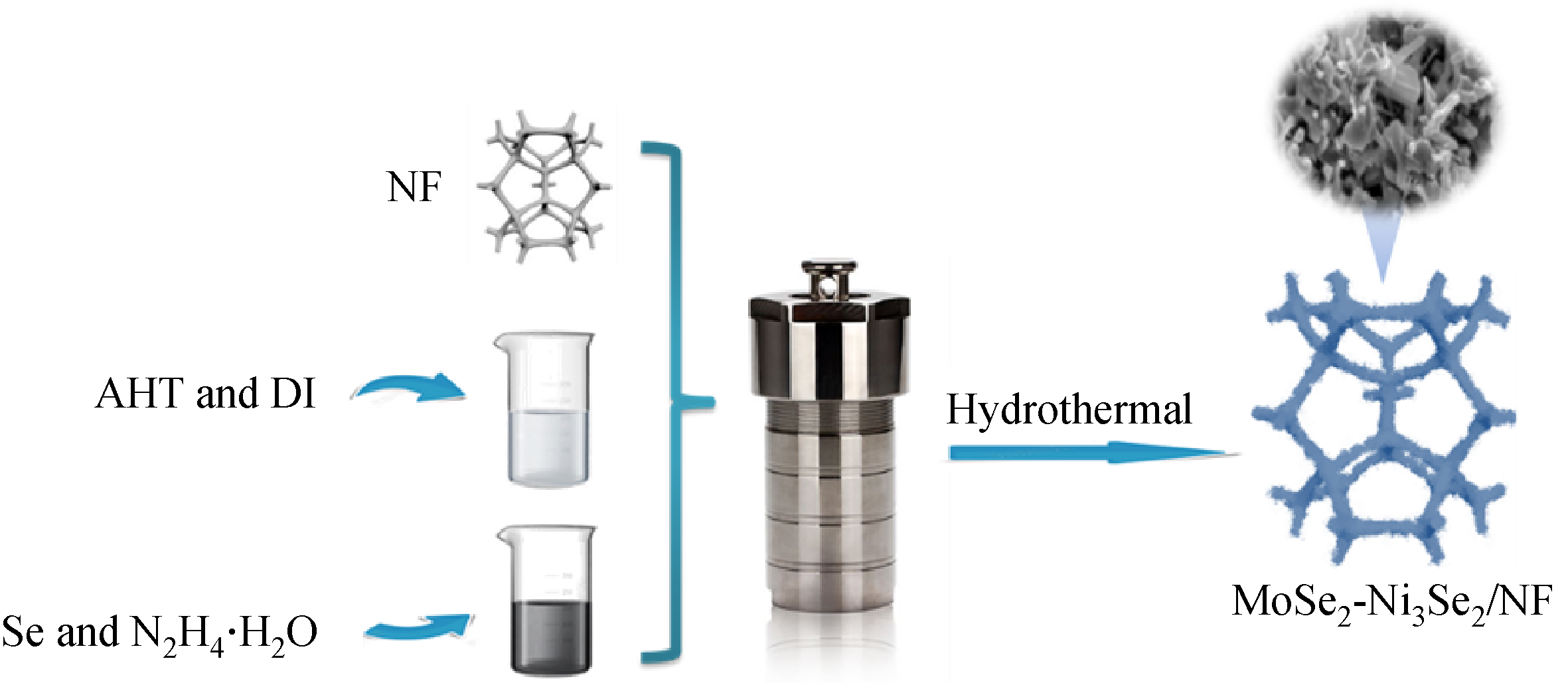

Facile route to achieve MoSe2-Ni3Se2 on nickel foam as efficient dual functional electrocatalysts for overall water splitting
Received date: 13 Aug 2021
Accepted date: 05 Nov 2021
Published date: 15 Jun 2022
Copyright
Since the catalytic activity of present nickel-based synthetic selenide is still to be improved, MoSe2-Ni3Se2 was synthesized on nickel foam (NF) (MoSe2-Ni3Se2/NF) by introducing a molybdenum source. After the molybdenum source was introduced, the surface of the catalyst changed from a single-phase structure to a multi-phase structure. The catalyst surface with enriched active sites and the synergistic effect of MoSe2 and Ni3Se2 together enhance the hydrogen evolution reactions (HER), the oxygen evolution reactions (OER), and electrocatalytic total water splitting activity of the catalyst. The overpotential of the MoSe2-Ni3Se2/NF electrocatalyst is only 259 mV and 395 mV at a current density of 100 mA/cm2 for HER and OER, respectively. MoSe2-Ni3Se2/NF with a two-electrode system attains a current density of 10 mA/cm2 at 1.60 V. In addition, the overpotential of HER and OER of MoSe2-Ni3Se2/NF within 80000 s and the decomposition voltage of electrocatalytic total water decomposition hardly changed, showing an extremely strong stability. The improvement of MoSe2-Ni3Se2/NF catalytic activity is attributed to the establishment of the multi-phase structure and the optimized inoculation of the multi-component and multi-interface.

Yuqi LIU , Yitong LIU , Yue YU , Chengzhan LIU , Shuangxi XING . Facile route to achieve MoSe2-Ni3Se2 on nickel foam as efficient dual functional electrocatalysts for overall water splitting[J]. Frontiers in Energy, 2022 , 16(3) : 483 -491 . DOI: 10.1007/s11708-022-0813-0
| 1 |
Bodhankar P M, Sarawade P B, Singh G,
|
| 2 |
Wang P, Jia T, Wang B. A critical review: 1D/2D nanostructured self-supported electrodes for electrochemical water splitting. Journal of Power Sources, 2020, 474: 228621
|
| 3 |
Zhao D, Zhuang Z, Cao X,
|
| 4 |
Han N, Liu P, Jiang J,
|
| 5 |
Li S, Hao X, Abudula A,
|
| 6 |
Li Z, Ge R, Su J,
|
| 7 |
Weng C, Ren J, Yuan Z. Transition metal phosphide-based materials for efficient electrochemical hydrogen evolution: a critical review. ChemSusChem, 2020, 13(13): 3357–3375
|
| 8 |
Yang Z, Zhao C, Qu Y,
|
| 9 |
Wang H, Fu W, Yang X,
|
| 10 |
Ding W, Cao Y, Liu H,
|
| 11 |
Tang Y, Liu Q, Dong L,
|
| 12 |
Hua W, Sun H, Xu F,
|
| 13 |
Yan P, Liu Q, Zhang H,
|
| 14 |
Sun H, Yan Z, Liu F,
|
| 15 |
Yao Q, Huang B, Zhang N,
|
| 16 |
Tiwari A P, Kim D, Kim Y,
|
| 17 |
Du H, Kong R, Guo X,
|
| 18 |
Ibraheem S, Li X, Shah S S A,
|
| 19 |
Kim D, Qin X, Yan B,
|
| 20 |
Feng X, Shi Y, Shi J,
|
| 21 |
Tian Y, Xue X, Gu Y,
|
| 22 |
Badrnezhad R, Nasri F, Pourfarzad H,
|
| 23 |
Zhang R, Wang G, Wei Z,
|
| 24 |
Barati Darband G, Aliofkhazraei M, Hyun S,
|
| 25 |
Jeghan S M N, Kim J, Lee G. Hierarchically designed CoMo marigold flower-like 3D nano-heterostructure as an efficient electrocatalyst for oxygen and hydrogen evolution reactions. Applied Surface Science, 2021, 546: 149072
|
| 26 |
Zhao Y, Zhang J, Xie Y,
|
| 27 |
Lv X, Xiao Z, Wang H,
|
| 28 |
Ma X, Li K, Zhang X,
|
| 29 |
Geng B, Yan F, Liu L,
|
| 30 |
Hu E, Yao Y, Chen Y,
|
| 31 |
Rajesh J A, Jo I R, Kang S H,
|
| 32 |
Yan H, Xie Y, Wu A,
|
| 33 |
Liu L, Yan F, Li K,
|
| 34 |
Zhu C, Yin Z, Lai W,
|
| 35 |
Wang Y, Liu J, Liao Y,
|
| 36 |
Li Z, Yang J, Chen Z,
|
| 37 |
Jamesh M I. Recent progress on earth abundant hydrogen evolution reaction and oxygen evolution reaction bifunctional electrocatalyst for overall water splitting in alkaline media. Journal of Power Sources, 2016, 333: 213–236
|
| 38 |
D’Olimpio G, Nappini S, Vorokhta M,
|
| 39 |
Yi X, He X, Yin F,
|
| 40 |
He L, Cui B, Hu B,
|
| 41 |
Zhang Y, Qiu Y, Ji X,
|
| 42 |
Zhu J, Ni Y. Phase-controlled synthesis and the phase-dependent HER and OER performances of nickel selenide nanosheets prepared by an electrochemical deposition route. CrystEngComm, 2018, 20(24): 3344–3352
|
| 43 |
Yang Y, Zhang K, Lin H,
|
| 44 |
Yang Y, Zhao X, Mao H,
|
| 45 |
Zhong Y, Chang B, Shao Y,
|
| 46 |
Liu N, Yang L, Wang S,
|
| 47 |
Liu W, Yu L, Yin R,
|
| 48 |
Zhang B, Xiao C, Xie S,
|
| 49 |
Feng L L, Yu G, Wu Y,
|
| 50 |
Shit S, Chhetri S, Jang W,
|
| 51 |
Liu J, Zhu D, Ling T,
|
| 52 |
Li J, Wei G, Zhu Y,
|
| 53 |
Chen T, Tan Y. Hierarchical CoNiSe2 nano-architecture as a high-performance electrocatalyst for water splitting. Nano Research, 2018, 11(3): 1331–1344
|
| 54 |
Wang H, Sun Y, Ma F,
|
/
| 〈 |
|
〉 |